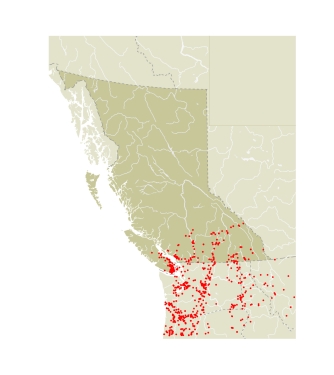The Western Spring Azure has two generations per year. The first flies from early April to early June and is abundant. The males congregate at mud puddles. There is a partial second generation in the warmer parts of southern BC, including southeastern Vancouver Island, near Hope, and the southern part of the Southern Interior. In California Comstock (1927) listed Ceanothus sp. as a larval foodplant. Ceanothus has been confirmed in the BC Southern Interior (FIS). On southeastern Vancouver Island, both Guppy (1954) and Hardy (GAH) have reared the Spring Azure on Holodiscus discolor. Hardy confined a female that had been walking on an inflorescence of H. discolor. It laid eggs on the inflorescence on 22-24 May; the eggs were a white, flattened sphere. The mature larvae had a black head with either an all green or purplish dorsal and green ventral body. Pupation occurred on 20-23 June. Regrettably Hardy did not record when the adults emerged.
Shepard observed adults of the Western Spring Azure in numbers along a long natural hedge of Spiraea douglasii at the back of sand dunes on Vancouver Island, but no oviposition was observed. This plant is found throughout the range of the species in BC and is likely a foodplant. In Colorado Scott (1992) found that adults with a wing pattern similar to that of BC populations oviposited primarily on Jamesia americana, a plant not found in our area. He also noted occasional oviposition on Prunus sp., and mentioned that that plant should be investigated for BC. Guppy (1954) found that the larvae fed exclusively on flowers. The larvae must pupate before winter since newly emerged adults are present in the earliest spring.
|
|
